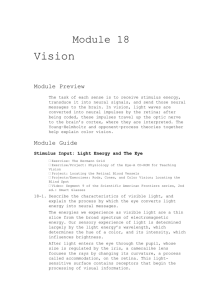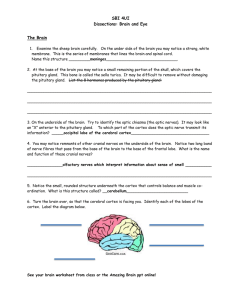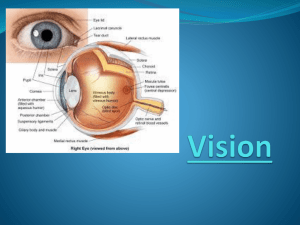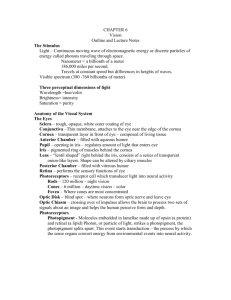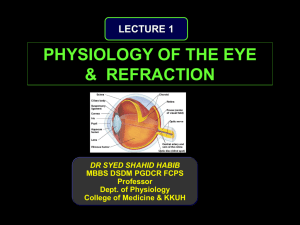Study Guide
advertisement
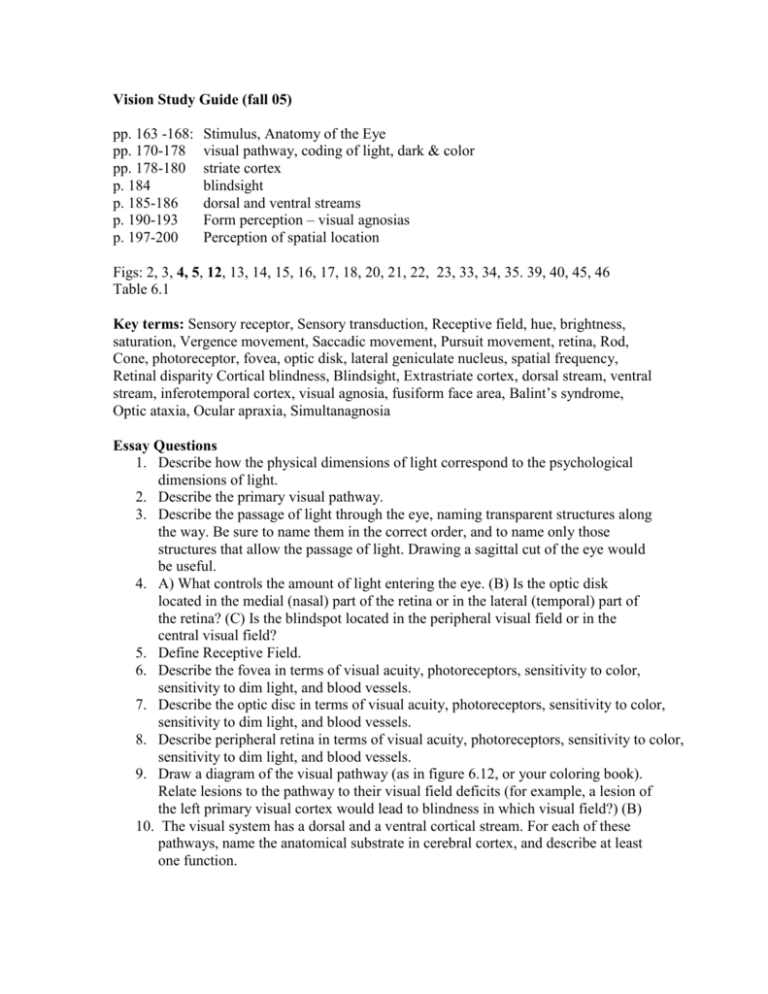
Vision Study Guide (fall 05) pp. 163 -168: pp. 170-178 pp. 178-180 p. 184 p. 185-186 p. 190-193 p. 197-200 Stimulus, Anatomy of the Eye visual pathway, coding of light, dark & color striate cortex blindsight dorsal and ventral streams Form perception – visual agnosias Perception of spatial location Figs: 2, 3, 4, 5, 12, 13, 14, 15, 16, 17, 18, 20, 21, 22, 23, 33, 34, 35. 39, 40, 45, 46 Table 6.1 Key terms: Sensory receptor, Sensory transduction, Receptive field, hue, brightness, saturation, Vergence movement, Saccadic movement, Pursuit movement, retina, Rod, Cone, photoreceptor, fovea, optic disk, lateral geniculate nucleus, spatial frequency, Retinal disparity Cortical blindness, Blindsight, Extrastriate cortex, dorsal stream, ventral stream, inferotemporal cortex, visual agnosia, fusiform face area, Balint’s syndrome, Optic ataxia, Ocular apraxia, Simultanagnosia Essay Questions 1. Describe how the physical dimensions of light correspond to the psychological dimensions of light. 2. Describe the primary visual pathway. 3. Describe the passage of light through the eye, naming transparent structures along the way. Be sure to name them in the correct order, and to name only those structures that allow the passage of light. Drawing a sagittal cut of the eye would be useful. 4. A) What controls the amount of light entering the eye. (B) Is the optic disk located in the medial (nasal) part of the retina or in the lateral (temporal) part of the retina? (C) Is the blindspot located in the peripheral visual field or in the central visual field? 5. Define Receptive Field. 6. Describe the fovea in terms of visual acuity, photoreceptors, sensitivity to color, sensitivity to dim light, and blood vessels. 7. Describe the optic disc in terms of visual acuity, photoreceptors, sensitivity to color, sensitivity to dim light, and blood vessels. 8. Describe peripheral retina in terms of visual acuity, photoreceptors, sensitivity to color, sensitivity to dim light, and blood vessels. 9. Draw a diagram of the visual pathway (as in figure 6.12, or your coloring book). Relate lesions to the pathway to their visual field deficits (for example, a lesion of the left primary visual cortex would lead to blindness in which visual field?) (B) 10. The visual system has a dorsal and a ventral cortical stream. For each of these pathways, name the anatomical substrate in cerebral cortex, and describe at least one function. 11. Graph a bipolar cell with on-center/off-surround receptive field. Next to it, graph the response pattern of that cell and of the ganglion that receives its input. Graph the response when both center and surround are stimulated, when only center is stimulated, and when only surround is stimulated. 12. Describe functional and physiological properties of the magnocellular and parvocellular systems in lateral geniculate nucleus. 13. Describe how inputs from LGN center-surround cells are combined in primary visual cortex, so that V1 cells are responsive to line orientation (a graph would be useful). 14. Explain the concept of spatial frequency. 15. Explain the topographic organization of primary visual cortex. 16. Describe how colors are detected and processed in the retina. Make sure to describe the trichromatic hypothesis and the opponent-process hypothesis. 17. . What color would a person perceive when red and green cones are stimulated simultaneously? (yellow) Justify (a figure may be useful in answering part of this question). 18. It is impossible to perceive a reddish green: How does the theory of opponentprocess coding explain this phenomenon? 19. Explain blindsight. Be sure to describe which brain areas are involved, which the perceptual abilities are impaired, and which are relatively unimpaired. 20. . L.M. is a 58 year old male patient recovering from a stroke that extends to the right occipital lobe and inferior-temporal areas. How would you proceed to find out whether L.M. has visual agnosia? Describe the performance that would suggest agnosia. Be sure to name not only the task/s that the patient must fail, but also the one/s in which she must succeed, in order to be considered agnosic. Attention 1. Provide evidence of attentional effects in visual cortex (fMRI, ERP). 2. Describe a patient with neglect. Make sure to include brain location, side of hemisphere lesion, and performance in clinical tests.
